 Home » Articles » Species (fishes and plants)
» Goldfish types
Home » Articles » Species (fishes and plants)
» Goldfish types | Goldfish types | |
|
This is the start of a several part series of which goldfish types, maintenance, breeding, collecting eggs, and even shipping eggs and fry will be discussed. I hope to share facts as well as my own experience with these beautiful, but challenging fish. Who knows maybe even a few surprises along the way. Goldfish come in many shapes, sizes, and colours. All types of goldfish originated from the common single-tailed fish, Carassius auratus. Therefore all breeds of goldfish are of the species Carassius auratus. It took breeders many years of careful selective breeding and lots of patience to produce the different varieties that we see today. All double-tailed breeds have all their fins, with the exception of the dorsal, paired. An example of this pairing is the anal fins. In double-tailed types there are two anal fins. Quite often a very nice looking double-tailed goldfish has only a single anal fin. This means the fish is of lessor quality. Single-tailed breeds have single dorsal and anal fins, although I have seen single-tailed fish with some pairing. Some of these lessor quality fish are very beautiful fish and still deserve a place in our ponds or aquariums. With goldfish, beauty is really in the eye of the beholder. Goldfish come in a large variety of colours, that include greenish brown, orange, red, blue, black, bronze, olive green, dark brown, reddish brown, light brown, calico, red and white, and white. I’m sure someone is saying what about black and white? In my experience the only black and white goldfish I have seen are fish in the process of changing colours. It is the same with orange and black. Have you ever had the wonderful experience of your beautiful black moor turning orange? Colour changes in goldfish can HAPPEN!!!!!!!! How big will my goldfish get? Well, this brings to mind, a couple of years back, when an older (and I might add educated) man asked me this question (seriously): "If I put a goldfish in the ocean, will it grow as big as the ocean?". Well, I really had a hard time answering this question. Not because I did not know the answer, but because I didn’t want to embarrass this gentleman. It was really hard not to laugh. Can you see what’s wrong with this question? For starters, goldfish are freshwater fish, and no they will not grow as big as the ocean. Most – and I stress most – fancy goldfish will get between 10cm and 15cm in length, not including fins. I have seen a couple 20cm black moors though, so that is why I stressed most. Single-tailed goldfish can grow to a length of 40cm or more. I would also like to point out here that if goldfish don’t have proper nutrition and housing, they may become stunted. Stunted goldfish are not a pretty sight. Did you know that most goldfish varieties are intended to be viewed from above? To get the full effect of most of the unusual characteristics you would have to look down at them. But they can be very beautiful when viewed from the side (as in an aquarium) as well. HEAD GROWTH TYPES The head growths on these fish come in a variety of shapes and sizes. Some cover just the top of the head, some cover the tops and cheeks and some cover the whole head. The head growths get larger as the fish gets older. ORANDA 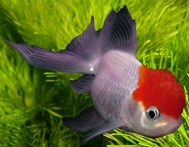 The oranda is a double-tailed fish. It has a short, round body with a dorsal fin. The head growths on the oranda can cover the whole head. Some orandas have growths only on the top of their head. This type is better known as the high head. The red-cap oranda is one that falls into this category. Some orandas (with whole head growth) get so large it eventually smothers the fish. I personally prefer the high head types. The oranda is a double-tailed fish. It has a short, round body with a dorsal fin. The head growths on the oranda can cover the whole head. Some orandas have growths only on the top of their head. This type is better known as the high head. The red-cap oranda is one that falls into this category. Some orandas (with whole head growth) get so large it eventually smothers the fish. I personally prefer the high head types.LIONHEAD 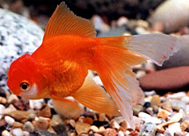 The lionhead is a double-tailed breed with no dorsal fin. It has a short rectangular body with a small double-tail. The back has a gentle, even curve, which is carried right to the peduncle. Good lionheads can have head growth nearly as large as the body is long. But good lionheads are hard to find. Most found in pet stores have bumpy, lumpy backs. I personally do not find bumpy lumpy goldfish appealing. The lionhead is a double-tailed breed with no dorsal fin. It has a short rectangular body with a small double-tail. The back has a gentle, even curve, which is carried right to the peduncle. Good lionheads can have head growth nearly as large as the body is long. But good lionheads are hard to find. Most found in pet stores have bumpy, lumpy backs. I personally do not find bumpy lumpy goldfish appealing.RANCHU The ranchu is another double-tailed breed without a dorsal fin. It has an egg shaped body. The curve of the back is slightly more pronounced than that of the lionhead, and has a sharp downward turn of the peduncle. Ranchus have much less head growth than lionheads. The edonoshiki is a calico ranchu with some metallic scales. In recent years lionhead and ranchu characteristics have been combined to the point where it is difficult to tell one from the other. Once again lumpy, bumpy-backed fish are found, some even with dorsal spikes EYE TYPES These mutations just add to the beauty of the individual fish. The various eye types range from gazing upward, to protruding and even to sacs filled with water under the eyes BUBBLE-EYE 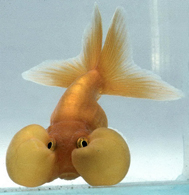 The most obvious characteristic of the bubble-eye is the large water filled sacks under the eyes that jiggle as they swim. The bubbles can be as wide as the fish is long. The bubbles should be even or of equal size on both sides. The body is cigar shaped with double fins in proportion to the body. This type is most often seen is without a dorsal, but some dorsal varieties do exist. The bubbles come in two different types. The first is the "boxer glove" shaped bubbles. These bubbles are shaped like a boxer’s glove because the eyes of the fish are attached to the head. The second shape is nearly round with the eyes actually gazing upward almost floating on the bubble. Very poor quality bubble-eyes are seen frequently. Either with broken bubbles from poor handling or uneven bubbles. This is another one of the types that can have bumpy, lumpy backs. A good quality bubble eye is a sight to behold. The most obvious characteristic of the bubble-eye is the large water filled sacks under the eyes that jiggle as they swim. The bubbles can be as wide as the fish is long. The bubbles should be even or of equal size on both sides. The body is cigar shaped with double fins in proportion to the body. This type is most often seen is without a dorsal, but some dorsal varieties do exist. The bubbles come in two different types. The first is the "boxer glove" shaped bubbles. These bubbles are shaped like a boxer’s glove because the eyes of the fish are attached to the head. The second shape is nearly round with the eyes actually gazing upward almost floating on the bubble. Very poor quality bubble-eyes are seen frequently. Either with broken bubbles from poor handling or uneven bubbles. This is another one of the types that can have bumpy, lumpy backs. A good quality bubble eye is a sight to behold.CELESTIAL 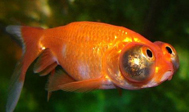 The celestial is another double-tailed type without a dorsal fin. Its body is like the bubble-eye with the fins in proportion. The eyes protrude from the head and gaze upward. The protruding eyes should be the same size and point in the same direction. The celestial is another double-tailed type without a dorsal fin. Its body is like the bubble-eye with the fins in proportion. The eyes protrude from the head and gaze upward. The protruding eyes should be the same size and point in the same direction.TELESCOPE 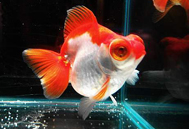 The telescope has eyes that protrude similar to the celestial, except the eyes do not gaze upward. The shape of the eyes can vary with each fish but the extension of the eyes should be balanced. The telescope is also a double-tailed fish whose body shape is short and round, similar to the ryukin. One well known telescope is the black moor, but they do come in other colours as well. I have found if very difficult to find a black moor that keeps its black colour. They usually turn red. When purchasing young fish, don’t be too disappointed if the end result is an orange or white telescope. Enjoy these fish for the beauties that they are. The telescope has eyes that protrude similar to the celestial, except the eyes do not gaze upward. The shape of the eyes can vary with each fish but the extension of the eyes should be balanced. The telescope is also a double-tailed fish whose body shape is short and round, similar to the ryukin. One well known telescope is the black moor, but they do come in other colours as well. I have found if very difficult to find a black moor that keeps its black colour. They usually turn red. When purchasing young fish, don’t be too disappointed if the end result is an orange or white telescope. Enjoy these fish for the beauties that they are.PEARLSCALE 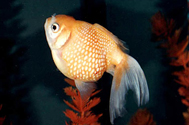 The pearlscale’s body is shaped like a ball, very round. This is also a double-tailed type. Each scale is white in colour and looks like a pearl. In good quality fish the pearl scales will go right up over the dorsal line (top of the body). Normally this fish does not have any head growths. This double-tailed fish with head growth is called a hamanishiki The pearlscale’s body is shaped like a ball, very round. This is also a double-tailed type. Each scale is white in colour and looks like a pearl. In good quality fish the pearl scales will go right up over the dorsal line (top of the body). Normally this fish does not have any head growths. This double-tailed fish with head growth is called a hamanishikiCHINESE POM POM 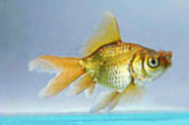 The Chinese pom pom is a dorsal-less type with a lionhead type body with no head growth. The pom pom’s are found over the fishes nostrils and grow to about the size of a pea. These fish are not commonly found, however the characteristics of the pom pom has been bred into many types of goldfish. So therefore goldfish with the pom pom characteristic is seen on occasion in pet stores. The Chinese pom pom is a dorsal-less type with a lionhead type body with no head growth. The pom pom’s are found over the fishes nostrils and grow to about the size of a pea. These fish are not commonly found, however the characteristics of the pom pom has been bred into many types of goldfish. So therefore goldfish with the pom pom characteristic is seen on occasion in pet stores.VEILTAIL The veiltail has an egg shaped body and long graceful finnage. It has a pointed head with no head growth. This double-tailed type has a very square cut tail and very high dorsal fin. There is some controversy over whether the veiltail is a true breed, and whether or not it actually originated in the US. Some circles believe that there is no such breed, but that it is nothing but a characteristic bred into many types of goldfish. The problem with this argument is that many characteristics of the different types have been bred into and combined with different types of goldfish. Other people believe that the proper veiltail only comes in one colour: orange. A few years ago, I was lucky enough to have some of these beautiful fish shipped to me from the breeder’s circle of The Goldfish Society. These fish were blue and calico. These particular fish came from (if I understood correctly) a cross made between two goldfish strains found within the Society. I don’t want to go into to much detail for it is not needed for the scope of this column. No matter what the controversy, these were very beautiful fish! FANTAIL The fantail is a very popular double-tailed type found in most fish stores. The head comes to a point and has no head growth. The finnage is in proportion to the body. This is a good fish for the beginning aquarist, as it is one of the easier fancy goldfish to keep and breed. RYUKIN 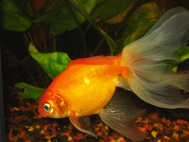 The Japanese ryukin has a rounded body with a highly developed, humped back. The Chinese ryukin does not have the hump as highly developed. It is also another good double-tailed type for the beginning aquarist. It is also a good fish for the beginning goldfish breeder to start with. Older ryukins can have some head growth. The hump and the head growths are stored fat. This is my favorite of all the different types of goldfish. The Japanese ryukin has a rounded body with a highly developed, humped back. The Chinese ryukin does not have the hump as highly developed. It is also another good double-tailed type for the beginning aquarist. It is also a good fish for the beginning goldfish breeder to start with. Older ryukins can have some head growth. The hump and the head growths are stored fat. This is my favorite of all the different types of goldfish.SINGLE TAIL VARIETIES The single tail varieties are the oldest goldfish types. They get much larger than the fancier types, reaching up to 40cm or larger. They are a good choice for the outdoor pond because they are competitive and fast enough to avoid predators most of the time. COMMON GOLDFISH  The common goldfish has a shape usually associated with fish. The finnage is relatively short. Typical colours are orange, red and white, white, green, and brownish green. Orange is the most common. The common goldfish has a shape usually associated with fish. The finnage is relatively short. Typical colours are orange, red and white, white, green, and brownish green. Orange is the most common.COMET  The comet’s main characteristic is the long finnage. The tail fin should be at least as long as the body with the lobes of the tail ending in a point. The body shape is a little more slender than the common, and they come in the same colours as the common goldfish. The comet’s main characteristic is the long finnage. The tail fin should be at least as long as the body with the lobes of the tail ending in a point. The body shape is a little more slender than the common, and they come in the same colours as the common goldfish.SHUBUNKIN 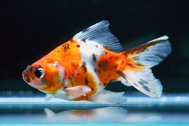 The shubunkin is a calico breed that comes in both the shape of the comet and common goldfish. The calico colours should have areas of blue, patches of red, pure white, and random black spots covering the body. It is believed that the more blue colour the higher the quality of the fish. The shubunkin is a calico breed that comes in both the shape of the comet and common goldfish. The calico colours should have areas of blue, patches of red, pure white, and random black spots covering the body. It is believed that the more blue colour the higher the quality of the fish.There are a variety of different characteristics that have been selectively bred to produce various other types. Just about any combination of characteristics can and have been bred and combined, to produce some very interesting looking fish. This had best be left to the more experienced goldfish breeder. CONCLUSION As can be seen from the many descriptions, goldfish are beautiful and graceful aquarium fish. Each type of goldfish maintains the personality that probably made goldfish popular in the first place. These fish will follow you from one end of the pond or aquarium to the other begging for food. Each and every one can eat from your hand, if you are willing to take the time. So kick back and relax after a hard days work and feed those goldfish. What a way to lose the stress of the day. |
 Comments: 7 Comments: 7 Views: 22609 Views: 22609 | |||||||||||
| |||||||||||